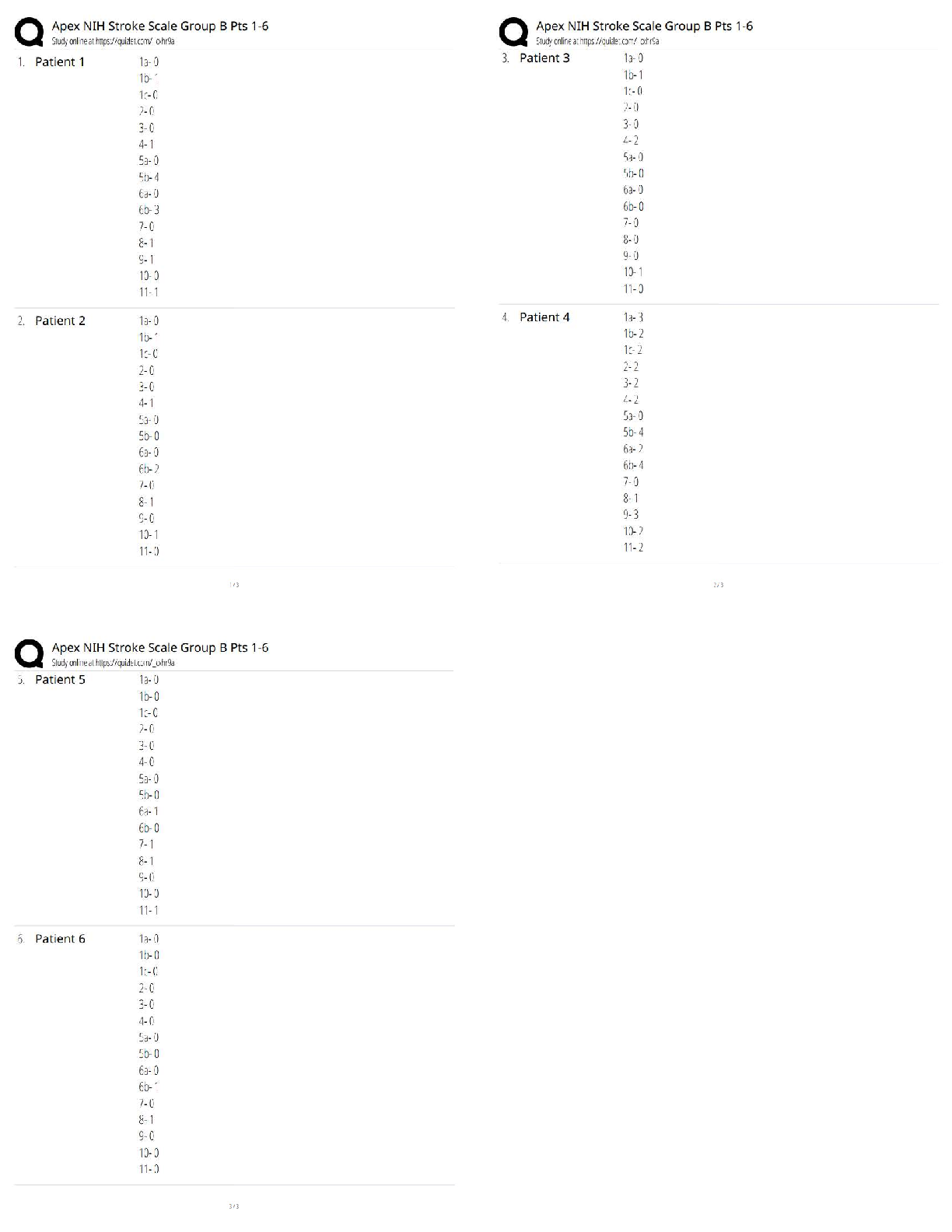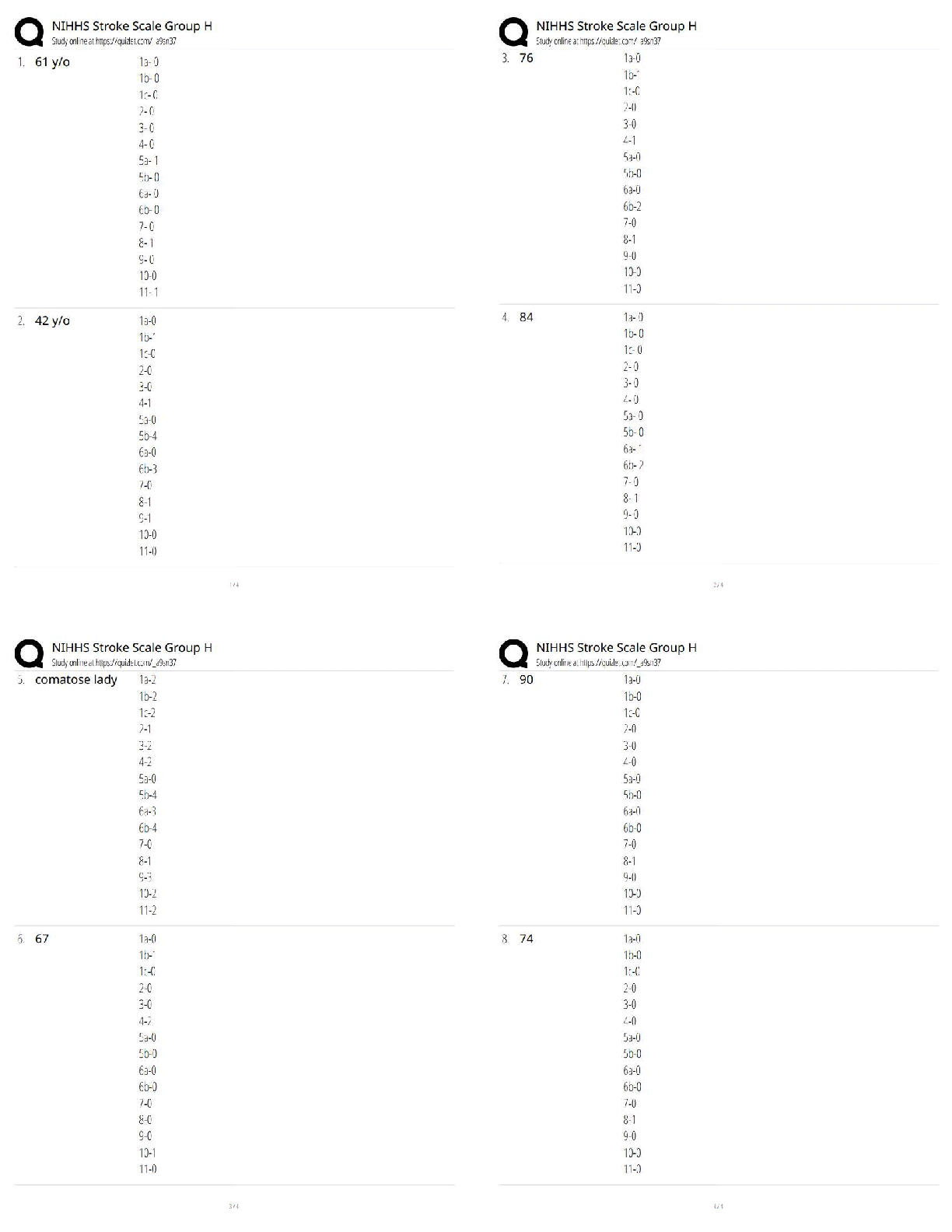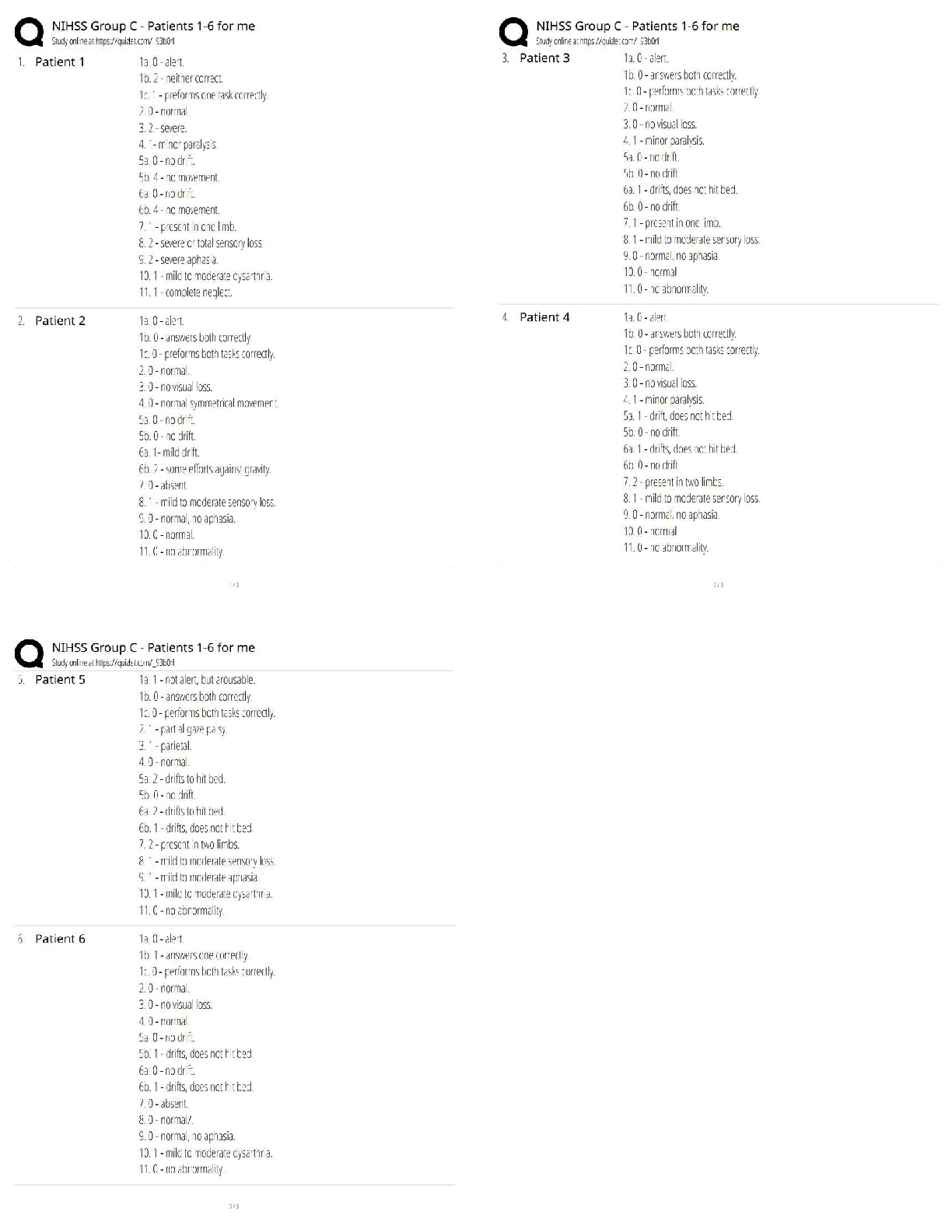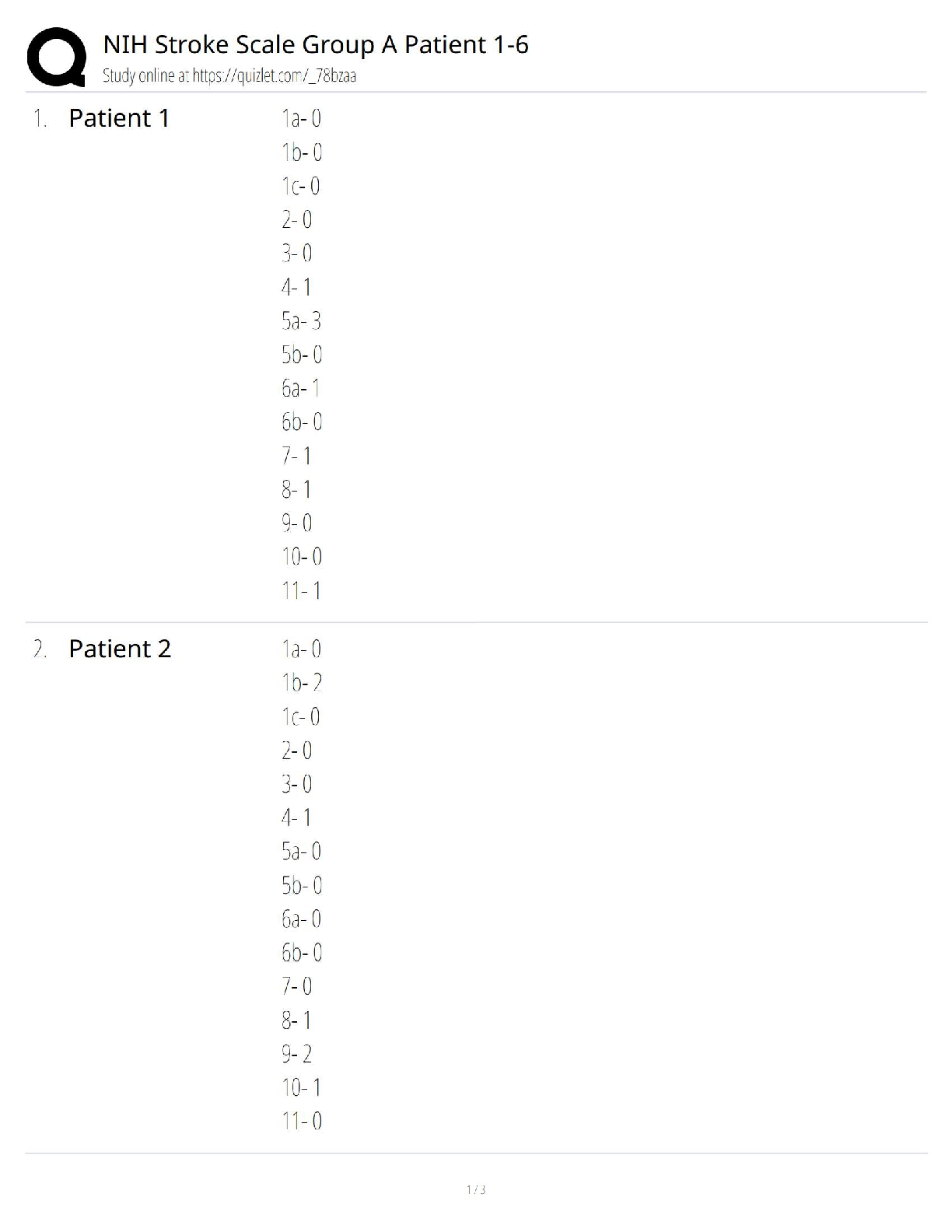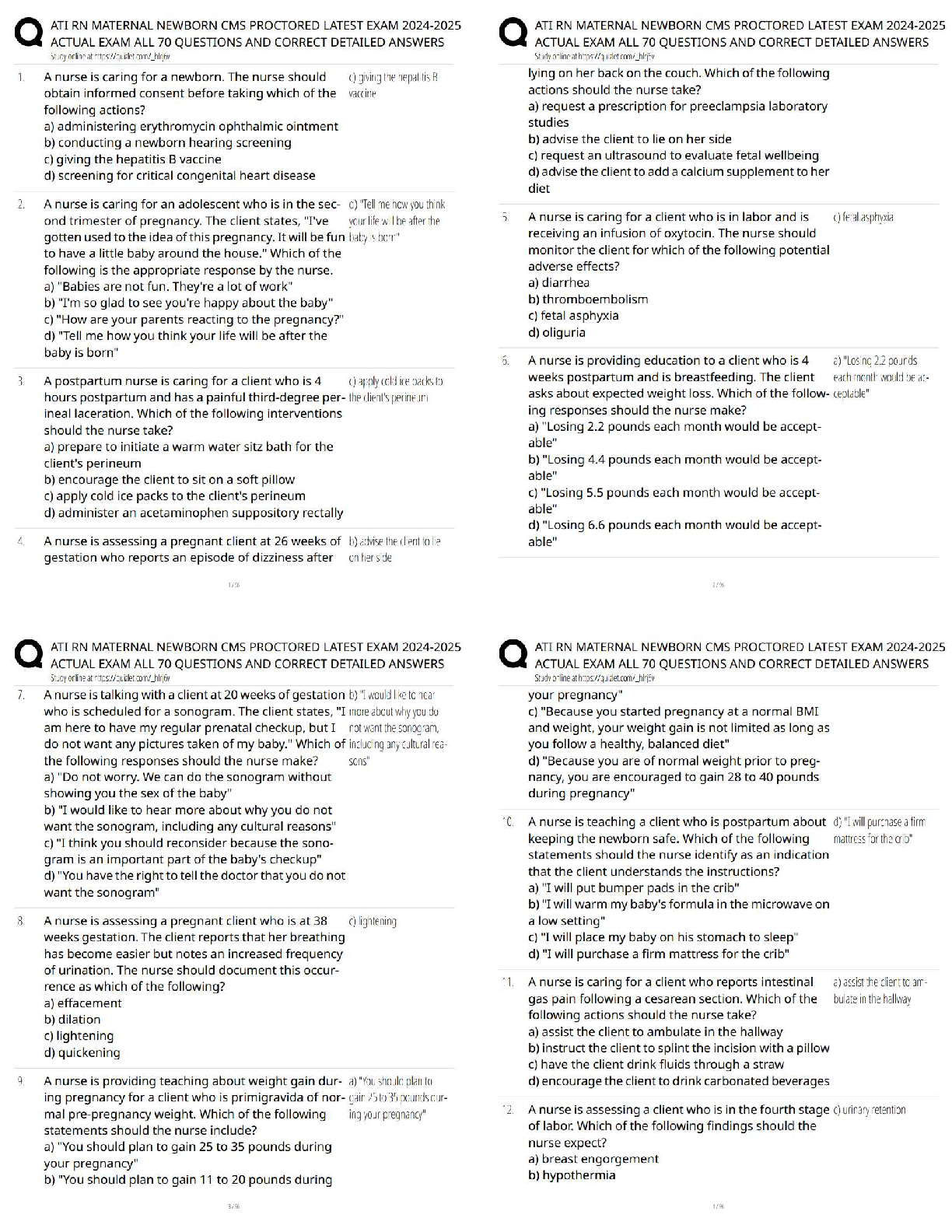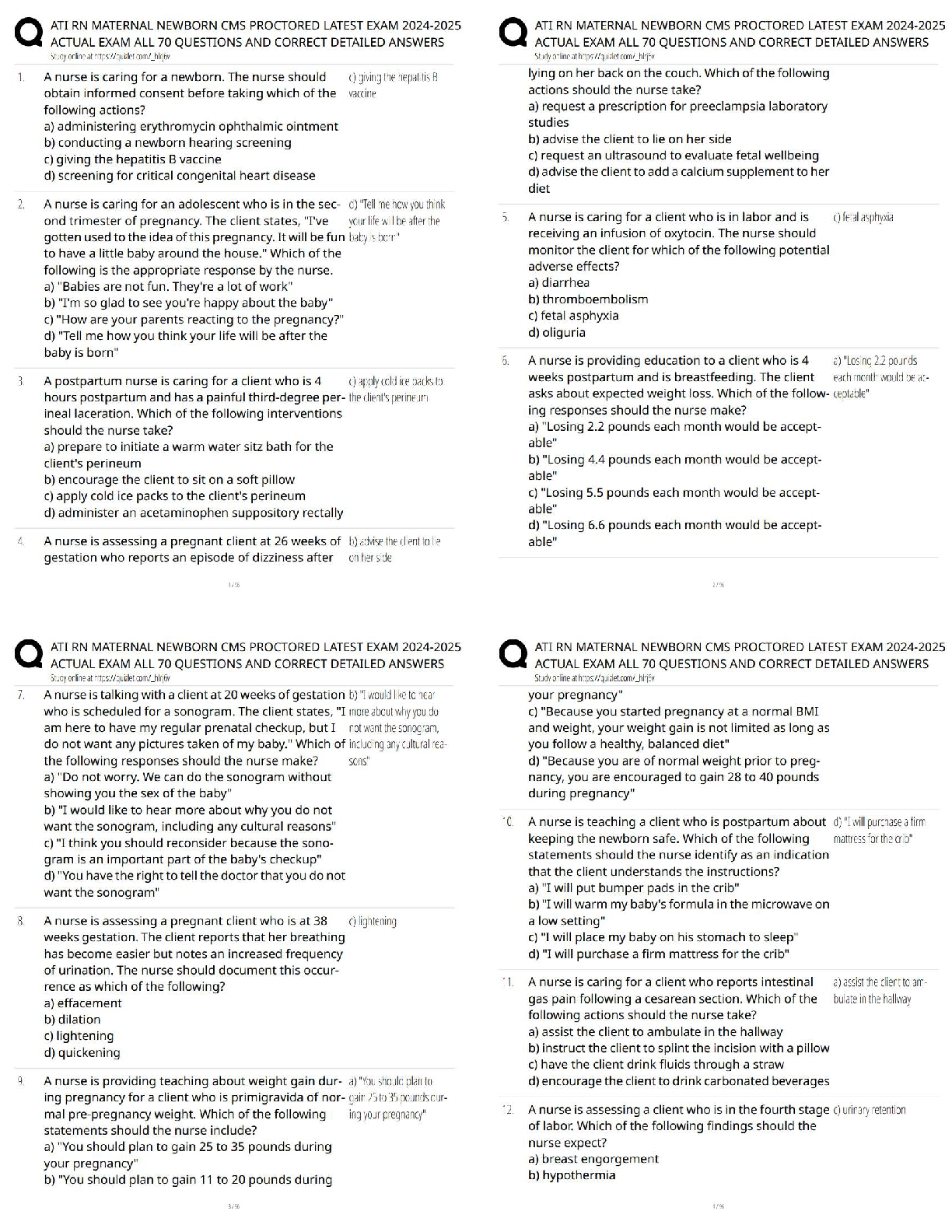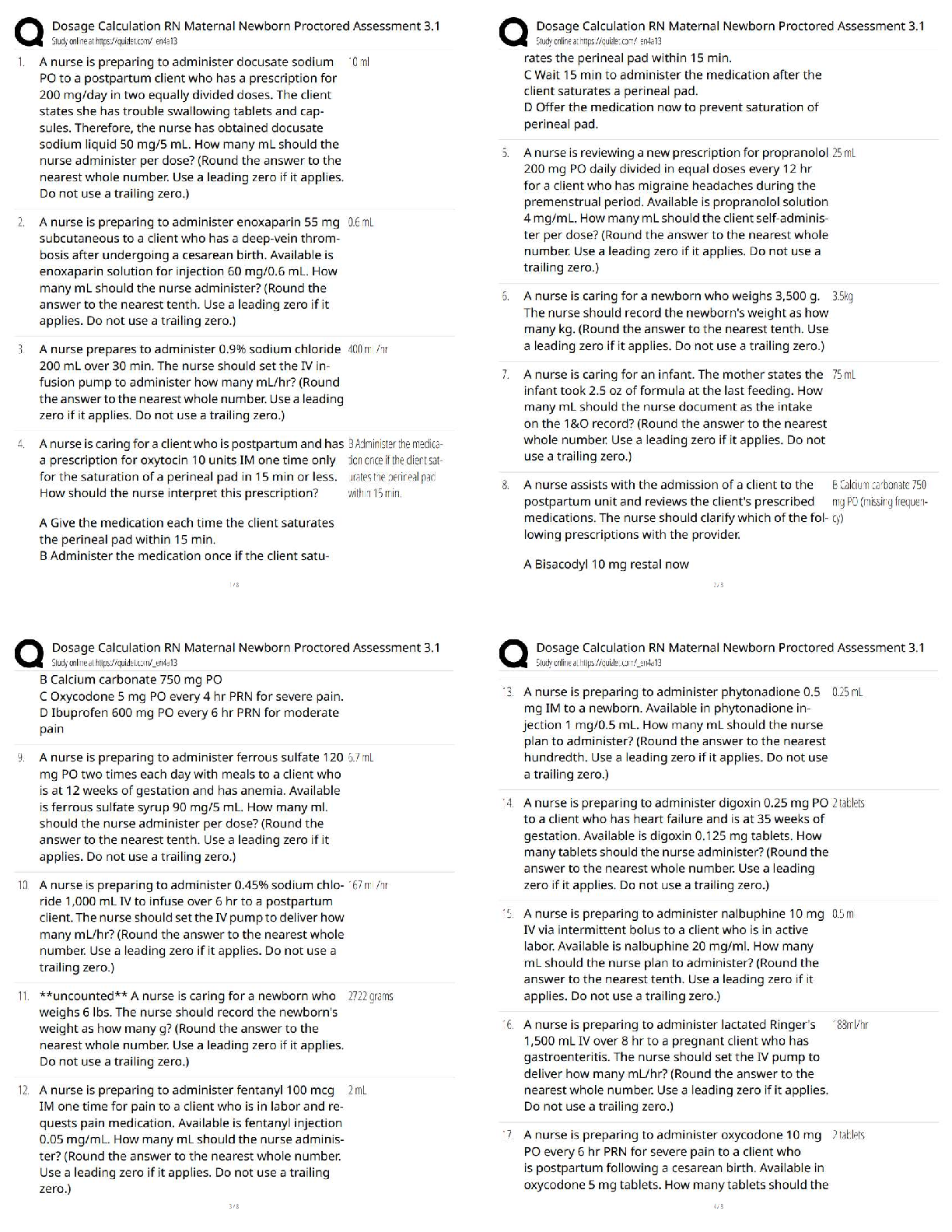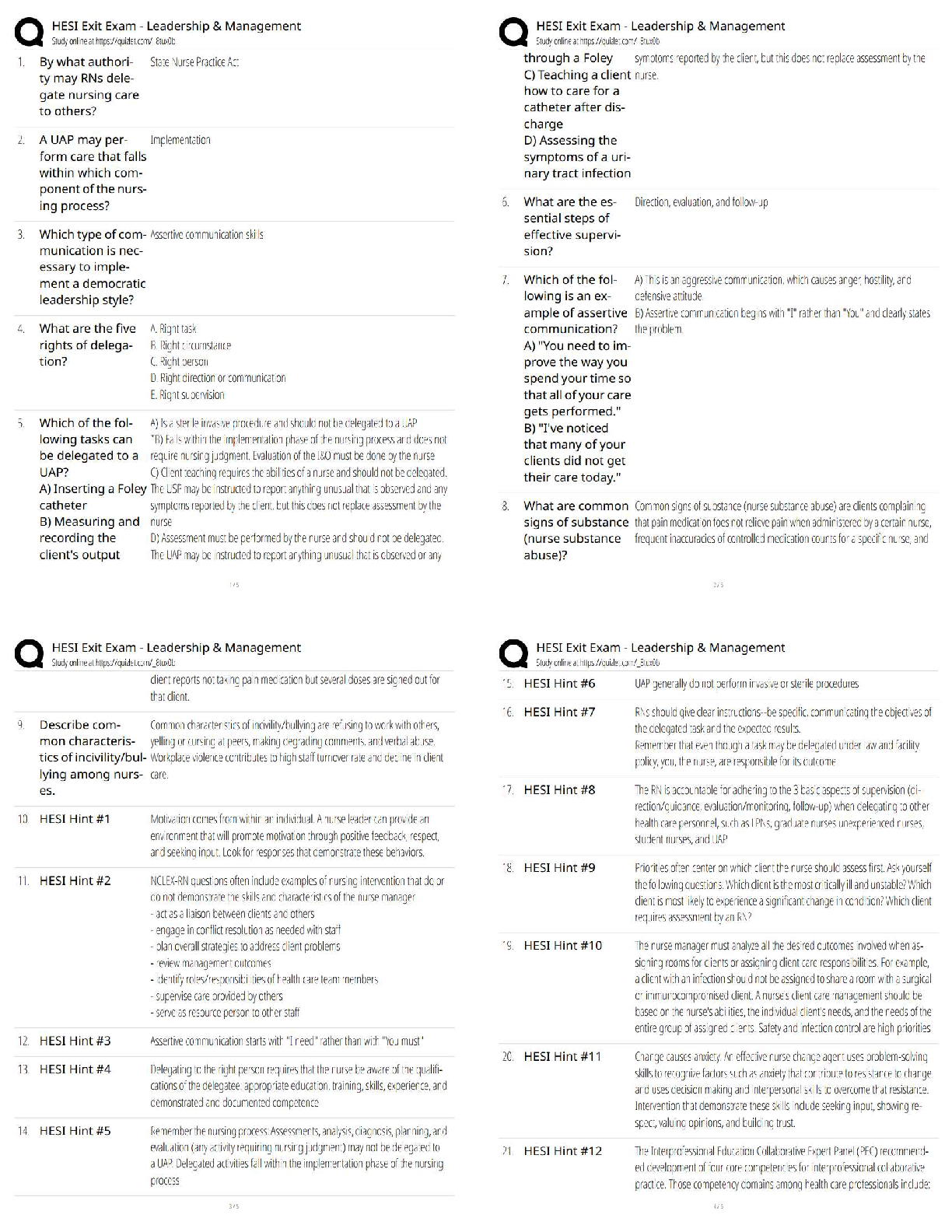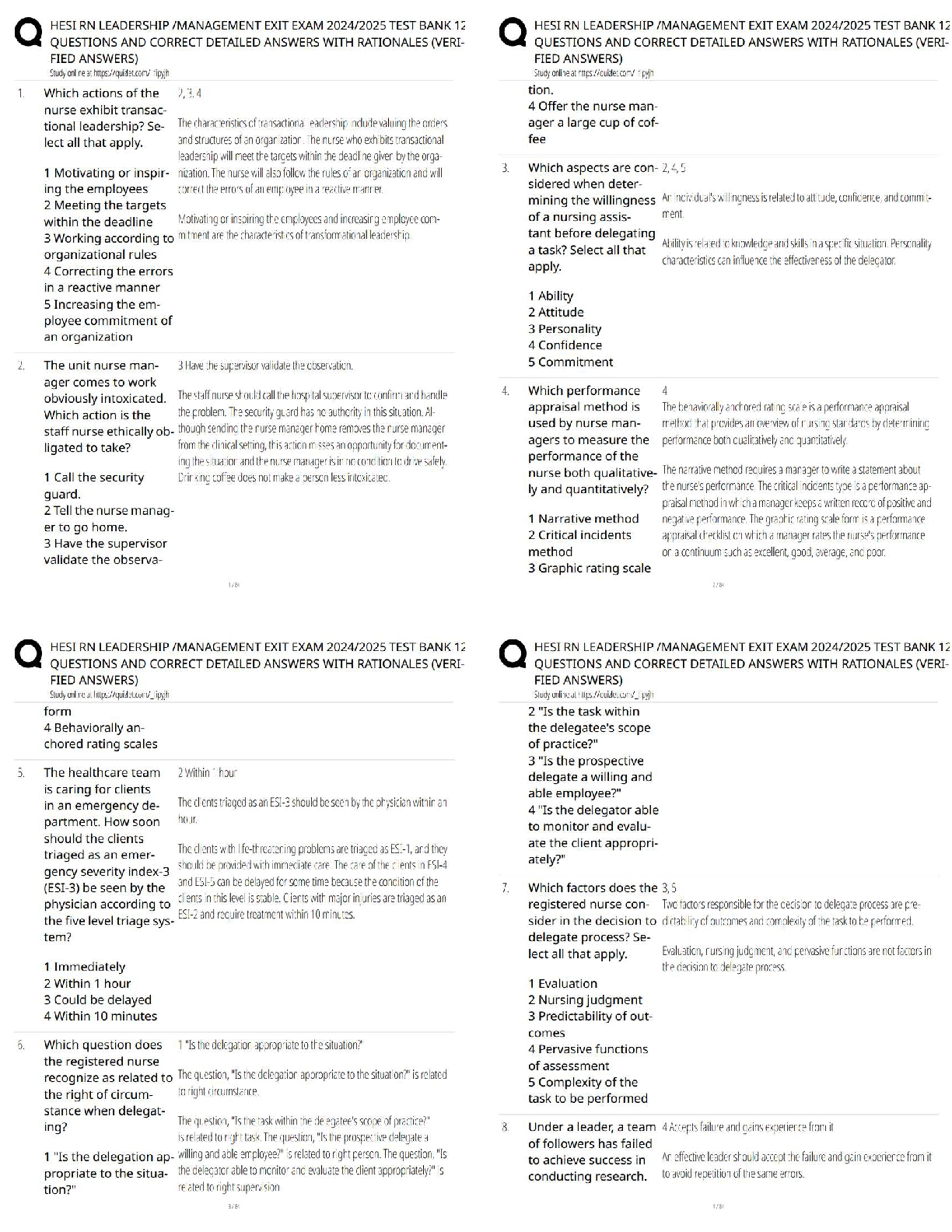Management > QUESTIONS & ANSWERS > CH 09 - Project Scheduling: PERT/CPM. All Answers Provided (All)
CH 09 - Project Scheduling: PERT/CPM. All Answers Provided
Document Content and Description Below
/ 1. It is normal for activities on the critical path to be delayed without delaying the entire project. a. b. ANSWER: POINTS: 1 DIFFICULTY: Easy LEARNING OBJECTIVES: IMS.AS ... WC.19.09.01 - 9.1 NATIONAL STANDARDS: United States - BUSPROG: Reflective Thinking TOPICS: 9.1 Project Scheduling Based on Expected Activity Times KEYWORDS: Bloom's: Remember 2. PERT and CPM are applicable only when there is no dependence among activities. a. b. ANSWER: POINTS: 1 DIFFICULTY: Easy LEARNING OBJECTIVES: IMS.ASWC.19.09.01 - 9.1 NATIONAL STANDARDS: United States - BUSPROG: Reflective Thinking TOPICS: 9.1 Project Scheduling Based on Expected Activity Times KEYWORDS: Bloom's: Remember 3. A path through a project network must reach every node. a. b. ANSWER: POINTS: 1 DIFFICULTY: Easy LEARNING OBJECTIVES: IMS.ASWC.19.09.01 - 9.1 NATIONAL STANDARDS: United States - BUSPROG: Reflective Thinking TOPICS: 9.1 Project Scheduling Based on Expected Activity Times KEYWORDS: Bloom's: Understand 4. A critical activity can be part of a noncritical path. a. b. ANSWER: POINTS: 1 DIFFICULTY: Easy LEARNING OBJECTIVES: IMS.ASWC.19.09.01 - 9.1 NATIONAL STANDARDS: United States - BUSPROG: Reflective Thinking TOPICS: 9.1 Project Scheduling Based on Expected Activity Times KEYWORDS: Bloom's: Understand 5. When activity times are uncertain, an activity's most likely time is the same as its expected time. a. b. ANSWER: POINTS: 1 DIFFICULTY: Easy LEARNING OBJECTIVES: IMS.ASWC.19.09.02 - 9.2 NATIONAL STANDARDS: United States - BUSPROG: Reflective Thinking TOPICS: 9.2 Project Scheduling Considering Uncertain Activity Times KEYWORDS: Bloom's: Understand 6. The final activity's earliest finish time is the anticipated project duration. a. b. ANSWER: POINTS: 1 DIFFICULTY: Easy LEARNING OBJECTIVES: IMS.ASWC.19.09.01 - 9.1 NATIONAL STANDARDS: United States - BUSPROG: Reflective Thinking TOPICS: 9.1 Project Scheduling Based on Expected Activity Times KEYWORDS: Bloom's: Understand 7. The length of time an activity can be delayed without affecting the project completion time is the slack. a. b. ANSWER: POINTS: 1 DIFFICULTY: Easy LEARNING OBJECTIVES: IMS.ASWC.19.09.01 - 9.1 NATIONAL STANDARDS: United States - BUSPROG: Reflective Thinking TOPICS: 9.1 Project Scheduling Based on Expected Activity Times KEYWORDS: Bloom's: Remember 8. When activity times are uncertain, total project time is normally distributed by considering the overall mean being equal to the sum of the means of all of the critical activities. a. b. ANSWER: POINTS: 1 DIFFICULTY: Easy LEARNING OBJECTIVES: IMS.ASWC.19.09.02 - 9.2 NATIONAL STANDARDS: United States - BUSPROG: Reflective Thinking TOPICS: 9.2 Project Scheduling Considering Uncertain Activity Times KEYWORDS: Bloom's: Understand 9. Crashing refers to an unanticipated delay in a critical path activity that causes the total time to exceed its limit. a. b. ANSWER: POINTS: 1 DIFFICULTY: Easy LEARNING OBJECTIVES: IMS.ASWC.19.09.03 - 9.3 NATIONAL STANDARDS: United States - BUSPROG: Reflective Thinking TOPICS: 9.3 Considering Time–Cost Trade-Offs KEYWORDS: Bloom's: Remember 10. Constraints in the LP models for crashing decisions are required to compare the activity's earliest finish time with the earliest finish time of each predecessor. a. b. ANSWER: POINTS: 1 DIFFICULTY: Moderate LEARNING OBJECTIVES: IMS.ASWC.19.09.03 - 9.3 NATIONAL STANDARDS: United States - BUSPROG: Reflective Thinking TOPICS: 9.3 Considering Time–Cost Trade-Offs KEYWORDS: Bloom's: Understand 11. The project manager should monitor the progress of any activity with a large time variance even if the expected time does not identify the activity as a critical activity. a. b. ANSWER: POINTS: 1 DIFFICULTY: Easy LEARNING OBJECTIVES: IMS.ASWC.19.09.02 - 9.2 NATIONAL STANDARDS: United States - BUSPROG: Reflective Thinking TOPICS: 9.2 Project Scheduling Considering Uncertain Activity Times KEYWORDS: Bloom's: Understand 12. The variance in the project completion time is the sum of the variances of all activities in the project. a. b. ANSWER: POINTS: 1 DIFFICULTY: Easy LEARNING OBJECTIVES: IMS.ASWC.19.09.02 - 9.2 NATIONAL STANDARDS: United States - BUSPROG: Reflective Thinking TOPICS: 9.2 Project Scheduling Considering Uncertain Activity Times KEYWORDS: Bloom's: Understand 13. The latest finish time for an activity is the largest of the latest start times for all activities that immediately follow the activity. a. b. ANSWER: POINTS: 1 DIFFICULTY: Easy LEARNING OBJECTIVES: IMS.ASWC.19.09.01 - 9.1 NATIONAL STANDARDS: United States - BUSPROG: Reflective Thinking TOPICS: 9.1 Project Scheduling Based on Expected Activity Times KEYWORDS: Bloom's: Understand 14. The earliest start time for an activity is equal to the smallest of the earliest finish times for all its immediate predecessors. a. b. ANSWER: POINTS: 1 DIFFICULTY: Easy LEARNING OBJECTIVES: IMS.ASWC.19.09.01 - 9.1 NATIONAL STANDARDS: United States - BUSPROG: Reflective Thinking TOPICS: 9.1 Project Scheduling Based on Expected Activity Times KEYWORDS: Bloom's: Understand 15. Shortening activity times, which is usually accomplished by adding resources to the project, is called crashing. a. b. ANSWER: POINTS: 1 DIFFICULTY: Easy LEARNING OBJECTIVES: IMS.ASWC.19.09.03 - 9.3 NATIONAL STANDARDS: United States - BUSPROG: Reflective Thinking TOPICS: 9.3 Considering Time–Cost Trade-Offs KEYWORDS: Bloom's: Remember 16. A key distinction of the critical path is that all activities on the critical path have zero slack time. a. b. ANSWER: POINTS: 1 DIFFICULTY: Easy LEARNING OBJECTIVES: IMS.ASWC.19.09.01 - 9.1 NATIONAL STANDARDS: United States - BUSPROG: Reflective Thinking TOPICS: 9.1 Project Scheduling Based on Expected Activity Times KEYWORDS: Bloom's: Understand 17. It is possible to have more than one critical path at a time. a. b. ANSWER: POINTS: 1 DIFFICULTY: Easy LEARNING OBJECTIVES: IMS.ASWC.19.09.01 - 9.1 NATIONAL STANDARDS: United States - BUSPROG: Reflective Thinking TOPICS: 9.1 Project Scheduling Based on Expected Activity Times KEYWORDS: Bloom's: Remember 18. Precedence relationships among activities are critical in CPM analysis but not in PERT. a. b. ANSWER: POINTS: 1 DIFFICULTY: Moderate LEARNING OBJECTIVES: IMS.ASWC.19.09.02 - 9.2 NATIONAL STANDARDS: United States - BUSPROG: Reflective Thinking TOPICS: 9.2 Project Scheduling Considering Uncertain Activity Times KEYWORDS: Bloom's: Understand 19. The normal distribution tends to be a better approximation of the distribution of total time for shorter projects where the critical path has relatively few activities. a. b. ANSWER: POINTS: 1 DIFFICULTY: Moderate LEARNING OBJECTIVES: IMS.ASWC.19.09.02 - 9.2 NATIONAL STANDARDS: United States - BUSPROG: Reflective Thinking TOPICS: 9.2 Project Scheduling Considering Uncertain Activity Times KEYWORDS: Bloom's: Understand 20. The earliest start time for an activity is equivalent to the latest of the earliest finish times for all its immediate predecessors. a. b. ANSWER: POINTS: 1 DIFFICULTY: Moderate LEARNING OBJECTIVES: IMS.ASWC.19.09.01 - 9.1 NATIONAL STANDARDS: United States - BUSPROG: Reflective Thinking TOPICS: 9.1 Project Scheduling Based on Expected Activity Times KEYWORDS: Bloom's: Understand Multiple Choice 21. PERT and CPM a. are most valuable when a small number of activities must be scheduled. b. have different features and are not applied to the same situation. c. do not require a chronological relationship among activities. d. have been combined to develop a procedure that uses the best of each. 22. Which of the following is NOT a significant challenge of project scheduling? a. Deadlines exist. b. Activities are independent. c. Many employees could be required. d. Delays are costly. 23. Arcs in a project network indicate a. completion times. b. precedence relationships. c. activities. d. the critical path. 24. We identify the critical path of a project as a. any path that goes from the starting node to the completion node. b. the combined time of all paths of the project. c. the shortest path through the project. d. the longest path through the project. 25. The earliest start time rule a. compares the starting times of all activities for successors of an activity. b. compares the finish times for all immediate predecessors of an activity. c. determines when the project can begin. d. determines when the project must begin. 26. Activities following a node a. can begin as soon as any activity preceding the node has been completed. b. have an earliest start time equal to the largest of the earliest finish times for all activities entering the node. c. have a latest start time equal to the largest of the earliest finish times for all activities entering the node. d. None of these are correct. 27. Activities G, P, and R are the immediate predecessors for activity W. If the earliest finish times for the three are 12, 15, and 10, then the earliest start time for W a. is 10. b. is 12. c. is 15. d. cannot be determined. 28. Activities K, M, and S immediately follow activity H, and their latest start times are 14, 18, and 11. The latest finish time for activity H a. is 11. b. is 14. c. is 18. d. cannot be determined. 29. When activity times are uncertain, a. we assume they are normally distributed. b. we start by calculating the optimistic, the most probable, and the pessimistic time estimates. c. we use the most probable time. d. we need to obtain at least four time estimates for each activity. 30. To determine how to crash activity times, a. normal activity costs and costs under maximum crashing must be known. b. shortest times with crashing must be known. c. realize that new paths may become critical. d. All of these are correct. 31. Slack equals a. LF – EF. b. EF – LF. c. EF – LS. d. LF – ES. 32. Activities with zero slack a. can be delayed. b. must be completed first. c. lie on a critical path. d. have no predecessors. 33. In deciding which activities to crash, one must crash a. all critical activities. b. largest-duration activities. c. lowest-cost activities. d. activities on the critical path(s) only. 34. For an activity with more than one immediate predecessor activity, which of the following is used to compute its earliest finish (EF) time? a. the largest EF among the immediate predecessors b. the average EF among the immediate predecessors c. the largest LF among the immediate predecessors d. the difference in EF among the immediate predecessors 35. Which of the following is always about a critical activity? a. LS = EF b. LF = LS c. ES = LS d. EF = ES 36. For an activity with more than one immediate successor activity, its latest finish time is equal to the a. largest latest finish time among its immediate successors. b. smallest latest finish time among its immediate successors. c. largest latest start time among its immediate successors. d. smallest latest start time among its immediate successors. 37. Which of the following is a general rule for crashing activities? a. Crash only noncritical activities. b. Crash activities with zero slack. c. Crash activities with the greatest number of predecessors. d. Crash the path with the fewest activities. 38. To calculate an activity’s latest finish time, you should consider its a. predecessors’ latest finish times. b. predecessors’ latest start times. c. successors’ earliest start times. d. successors’ latest start times. 39. A critical activity is a. an activity that consumes no time but shows precedence between events. b. a milestone accomplishment within the project. c. an activity with zero slack. d. the beginning of an event. 40. The main difference between CPM and PERT is a. CPM and PERT use different activity time estimates. b. PERT analysis is less expensive to conduct. c. PERT lends itself to computerization while CPM networks must be constructed manually. d. CPM integrates time and cost performance while PERT is based solely on time performance. 41. In PERT, the activity duration time is equal to the a. pessimistic time. b. optimistic time. c. most likely time. d. mean duration. Subjective Short Answer 42. From this schedule of activities, draw the PERT/CPM network. Activity Immediate Predecessor A — B A C B D B E A F C, D G E, F 43. From this PERT/CPM network, create a list of activities and their predecessors. ANSWER: Activity Immediate Predecessor A — B — C A D A, B E C, D F D G E H F, G POINTS: 1 DIFFICULTY: Moderate LEARNING OBJECTIVES: IMS.ASWC.19.09.01 - 9.1 NATIONAL STANDARDS: United States - BUSPROG: Analytic TOPICS: 9.1 Project Scheduling Based on Expected Activity Times KEYWORDS: Bloom's: Create 44. A cookie recipe gives the following numbered steps. 1. Preheat oven. 2. Grease cookie sheets. 3. Cream shortening and sugar. 4. Add eggs and flavoring. 5. Measure and sift dry ingredients. 6. Add dry ingredients to mixture. 7. Drop by spoonfuls onto sheets and bake for 10 minutes. Although the steps are numbered, they do not always reflect immediate precedence relationships. Develop a table that lists the immediate predecessors for each activity. 45. A senior MIS design class project team has developed the following schedule of activities for their project, using their best estimate of completion times. Both written and oral reports are required. Draw the project network. Can they complete the project in the 38 class days remaining until the end of the semester? Activity Time Immediate Predecessor A. Find client. 4 — B. Write prospectus. 2 A C. Obtain approval from client and professor. 3 B D. Complete programming. 12 C E. Do industry background research. 10 — F. Write final paper. 6 D, E G. Write oral report. 5 D, E 46. A project network is shown below. Use a forward and a backward pass to determine the critical path, and then fill out the table below. Activity times are in weeks. Activity Precedence Activities Activity Time (weeks) ES LS EF LF Slack Critical Path? A B C D E F G H I Now assume that the times listed are only the expected times instead of being fixed times. Is the probability of being finished in fewer than 25 weeks more or less than 50%? 47. A project network is shown below. Use a forward and a backward pass to determine the critical path, and then fill out the table below. Activity times are in weeks. Activity Precedence Activities Activity Time (weeks) ES LS EF LF Slack Critical Path? A B C D E F G H I Now assume that the times listed are only the expected times instead of being fixed times. Is the probability of being finished in more than 28 weeks more or less than 50%? 48. Use the following network of related activities with their duration times (weeks) to complete a row for each activity under the column headings below. Activity Immediate Predecessors Activity Time (weeks) ES LS EF LF Slack Critical Path? A B C D E F G H 49. Use the following network of related activities with their duration times (weeks) to complete a row for each activity under the column headings below. Activity Immediate Predecessors Activity Time (weeks) ES LS EF LF Slack Critical Path? A B C D E F G H I J 50. Use the following network with activities and times estimated in days to answer questions a through c. Activity Optimistic Most Probable Pessimistic A 2 5 6 B 1 3 7 C 6 7 10 D 5 12 14 E 3 4 5 F 8 9 12 G 4 6 8 H 3 6 8 I 5 7 12 J 12 13 14 K 1 3 4 a. What are the critical path activities? b. What is the expected time to complete the project? c. What is the probability the project will take more than 28 days to complete? 51. The critical path for this network is A - E - F, and the project completion time is 22 weeks. Activity Normal Time Crash Time Normal Cost Crash Cost A 12 8 8,000 12,000 B 14 10 5,000 7,500 C 8 8 10,000 10,000 D 5 3 6,000 8,000 E 4 3 5,000 7,000 F 6 5 9,000 12,000 G 10 8 5,000 8,000 If a deadline of 17 weeks is imposed, give the linear programming model for the crashing decision. 52. For the project represented below, determine the earliest and latest start and finish times for each activity as well as the expected overall completion time. Activity Duration ES EF LS LF Slack A 4 B 3 C 4 D 2 E 5 F 2 G 5 H 6 53. Consider the following PERT/CPM network with estimated times in weeks. The project is scheduled to begin on May 1. The three-time estimate approach was used to calculate the expected times and the following table gives the variance for each activity: Activity Variance Activity Variance A 1.1 E 0.3 B 0.5 F 0.6 C 1.2 G 0.6 D 0.8 H 1.0 a. Give the expected project completion date and the critical path. b. By what date are you 99% sure the project will be completed? 54. A project consists of five activities. Naturally, the paint mixing precedes the painting activities. Also, both ceiling painting and floor sanding must be done prior to floor buffing. Optimistic Most Probable Pessimistic Activity Time (hr.) Time (hr.) Time (hr.) Floor sanding 3 4 5 Floor buffing 1 2 3 Paint mixing 0.5 1 1.5 Wall painting 1 2 9 Ceiling painting 1 5.5 7 a. Construct the PERT/CPM network for this problem. b. What is the expected completion time of this project? c. What is the probability that the project can be completed within nine hours? 55. Consider a project that has been modeled as follows: Activity Immediate Predecessors Duration (hr.) A — 7 B — 10 C A 4 D A 30 E A 7 F B, C 12 G B, C 15 H E, F 11 I E, F 25 J E, F 6 K D, H 21 L G, J 25 a. Draw the PERT/CPM network for this project and determine the project's expected completion time and its critical path. b. Can activities E and G be performed simultaneously without delaying the minimum project completion time? c. Can one person perform A, G, and I without delaying the project? d. By how much can activities G and L be delayed without delaying the entire project? e. How much would the project be delayed if activity G was delayed by seven hours and activity L was delayed by four hours? Explain. 56. Joe King has ambitions to be mayor of Williston, North Dakota. Joe has determined the breakdown of the steps to the nomination and has estimated normal and crash costs and times for the campaign as follows (times are in weeks). Normal Crash Immediate Activity Time Cost Time Cost Predecessors A. Solicit volunteers 6 $5,000 4 $ 9,000 — B. Initial "free" exposure 3 4,000 3 4,000 — C. Raise money 9 4,000 6 10,000 A D. Organize schedule 4 1,000 2 2,000 A E. Hire advertising firm 2 1,500 1 2,000 B F. Arrange TV interview 3 4,000 1 8,000 B G. Advertising campaign 5 7,000 4 12,000 C, E H. Personal campaigning 7 8,000 5 20,000 D, F Joe is not a wealthy man and would like to organize a 16-week campaign at minimum cost. Write and solve a linear program to accomplish this task. 57. Marcy Fetter, a staff analyst at the Los Angeles plant of Computer Products Corporation, is assigned to the team that is developing the process design for producing an RFID sensor. The corporate planning group in San Jose, California, has contacted her and asked how confident the design group is about completing the project in 60 days. She has developed the following estimated time durations in days for the project: Activity Immediate Predecessor Activities Optimistic Time (to) Most Likely Time (tm) Pessimistic Time (tp) A — 10 12 15 B A 6 10 14 C A 10 15 20 D A 9 9 18 E B 5 6 8 F C, E 10 12 13 G B 12 14 16 H B, D 18 21 24 I B, D 10 15 20 J F, G, H 8 10 14 a. Compute the expected time and variance for each activity. b. Determine the critical path and expected duration of the project. c. What is the probability that the project will take longer than 58 days to complete? d. Which path in the project network offers the greatest risk of overrunning a new deadline of 56 days? 58. A project has the following activities, precedence relationships, and time estimates in weeks: Activity Immediate Predecessor Activities Optimistic Time (to) Most Likely Time (tm) Pessimistic Time (tp) A — 15 20 25 B — 8 10 12 C A 25 30 40 D B 15 15 15 E B 22 25 27 F E 15 20 22 G D 20 20 22 a. Compute the expected time and variance for each activity. b. Determine the critical path and the expected duration of the project. c. What is the probability that the project will take longer than 56 weeks to complete? 59. Three paths of a PERT network have these mean durations and variances in weeks: Path Mean Duration Variance 1 45 2.75 2 44 5.50 3 46 1.20 Which path offers the greatest risk of overrunning a contract deadline of 48 weeks? 60. A project has the following activities, durations, costs, and precedence relationships: Activity Present Duration (Weeks) Accelerated Duration (Weeks) Immediate Predecessor Activities Present Cost Accelerated Cost A 10 9 — $11,000 $15,000 B 15 13 — 20,000 25,000 C 10 6 A 9,000 20,000 D 20 18 A 25,000 30,000 E 15 10 C 20,000 35,000 F 17 15 B 20,000 30,000 G 12 10 B 15,000 25,000 H 9 8 D, F 12,000 18,000 I 7 6 G, H 10,000 15,000 Develop a time-cost trade-off analysis. Detail the steps that you would use to accelerate or crash the project to its minimum duration at the lowest cost. Determine each step's cost and the duration of the project. 61. National Oil Company (NATOCO) must plan the shutdown of its Houston refinery for routine preventive maintenance. Each hour of downtime is lost production time and is very costly, so NATOCO wants the maintenance project completed in 22 hours. The PERT network below shows the precedence relationships of the activities involved in the project. The table gives the activity times and costs under normal operations and maximum crashing. NATOCO wants to know the minimum cost of completing the maintenance project within the 22-hour period. Formulate and solve a linear program that will yield this information. Activity Normal Time (hr.) Normal Cost Crash Time (hr.) Crash Cost A 2 $2,000 1.5 $3,000 B 4 3,000 3 3,500 C 1 1,500 1 1,500 D 4 5,300 2.5 8,000 E 6 5,400 5 7,000 F 10 6,000 8 9,000 G 8 4,800 5 9,900 H 2 2,800 1 2,900 I 5 4,500 4 5,000 J 12 6,000 6 9,600 K 7 7,000 4 9,700 L 11 8,800 9 9,200 M 4 1,000 1 7,000 [Show More]
Last updated: 3 years ago
Preview 1 out of 33 pages

Buy this document to get the full access instantly
Instant Download Access after purchase
Buy NowInstant download
We Accept:

Reviews( 0 )
$6.00
Can't find what you want? Try our AI powered Search
Document information
Connected school, study & course
About the document
Uploaded On
Nov 07, 2019
Number of pages
33
Written in
All
Additional information
This document has been written for:
Uploaded
Nov 07, 2019
Downloads
0
Views
229


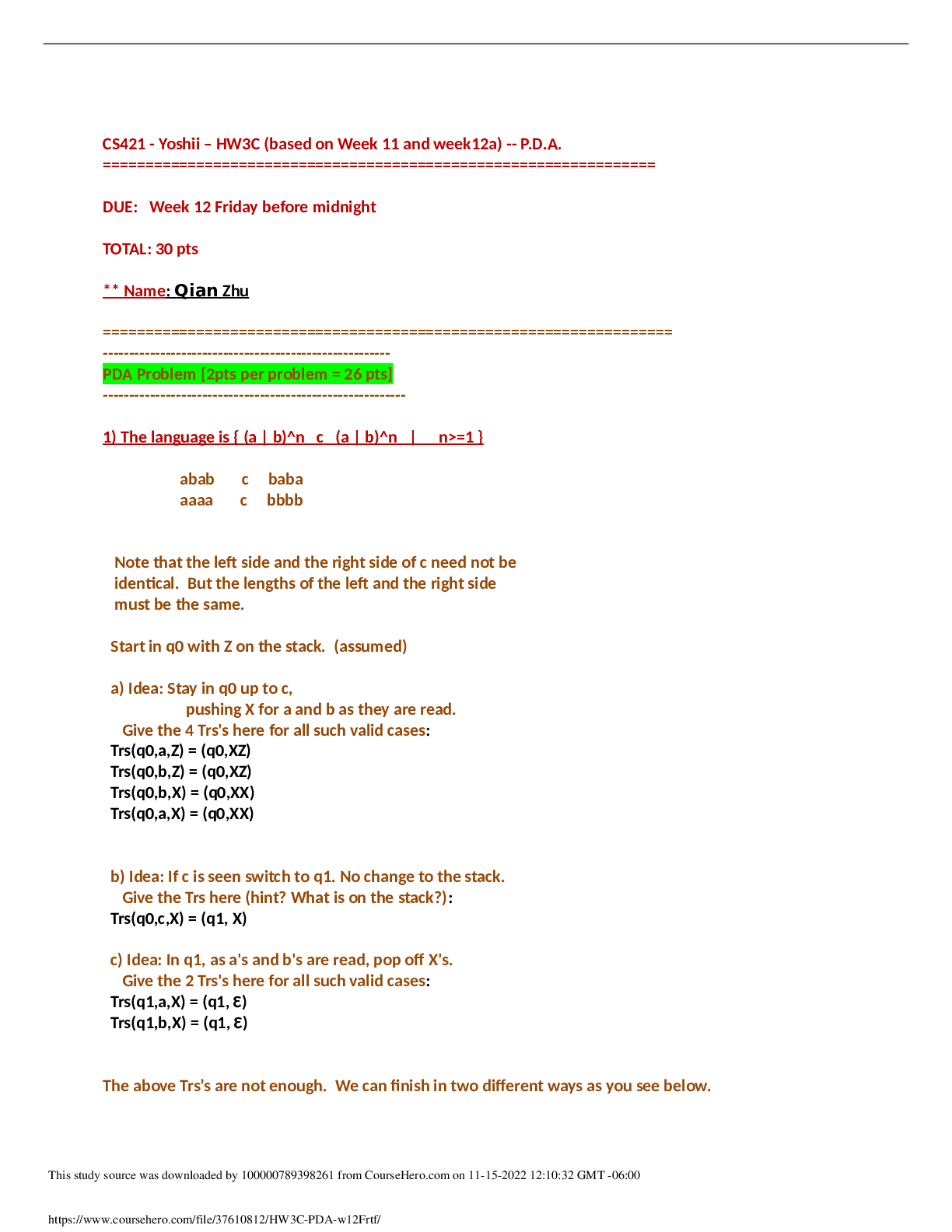


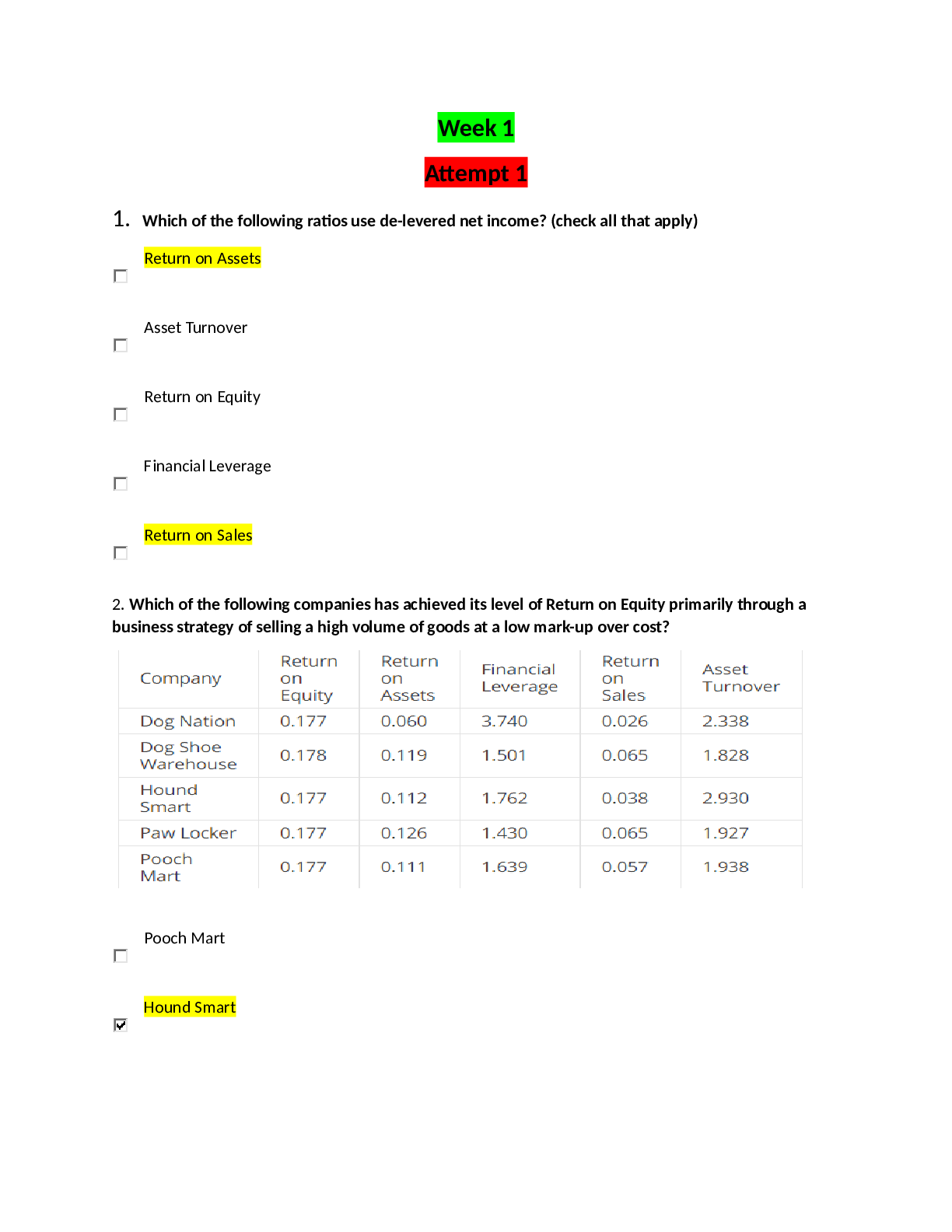
.png)
.png)
.png)
.png)
.png)
.png)
.png)


